New Brandeis University Magazine highlights the Heller School's uncommon resolve
Cover story looks at Heller's 'Agents of Change'
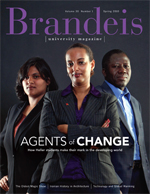 |
|
Download the spring |
An Uncommon Resolve
When the Hotel Montana collapsed Jan. 12 in a massive earthquake in Haiti’s capital, Port-au-Prince, Ann Varghese, MS’09, was plunged into darkness and enveloped in concrete dust and shards. Moments before, the development worker had been standing at the hotel’s front desk making impromptu dinner plans with colleagues. They had spent the day discussing the logistics of implementing a nationwide drug distribution program for neglected tropical diseases. In an instant, the Kansas native and four others were buried alive beneath five stories of concrete rubble.
“We were all in a little compartment; it was really amazing, but the space was made for us,” says Varghese. “Behind us was the front desk, on the other three sides were concrete beams that had fallen, and the ceiling was right above us. If we had been six inches to the right or to the left, we would have been completely crushed. The five of us were contained, but there was no place to go.”
Thus began a harrowing ordeal that tested Varghese physically, emotionally, and psychologically. Without water or the ability to communicate with the outside world—almost the only sign of life she heard was the occasional whirring helicopter rotor slicing the air—Varghese and her colleagues were trapped in a three-foot-high cement cavern whose stability they worried about constantly.
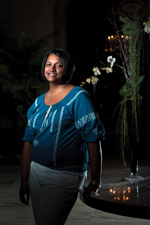 |
| Ann Varghese, MS'09 |
Through the first night, the group believed they would be rescued any moment. But as the hours wore on, Varghese, growing severely dehydrated, sank into despair, her spirits lifted briefly by praying and singing aloud with the others. On the cusp of her third night she feared she wouldn’t survive until morning. Soon after, they heard the voices of French firefighters coming to their rescue. It took five hours to extricate four of the group, who were pulled by their legs while lying on their backs, through an excruciatingly small passageway the rescuers made for them. After fifty-five hours in the rubble, Varghese was the last to be pulled out. Two died due to severe injuries, one in a hospital in Florida, one at the hotel. Miraculously, Varghese didn’t even need a Band-Aid.
The earthquake literally shook the hotel to its foundation; still, it never managed to shake Varghese’s resolve to continue her work as a program officer helping eradicate preventable disease in developing nations. “This experience was a test of our physical strength, of our faith, of our commitment to this work,” says the thirty-one-year-old, who spent six years in international development, including two years as a health volunteer in Cameroon with the Peace Corps, before earning a master’s in international health policy and management at Heller. “It’s not easy to choose this work or stick with it, but I cannot see myself doing anything else.”
Despite the trauma, Varghese—after visiting her family in Kansas and returning to her own home in Baltimore—immediately went back to work at IMA World Health, a nonprofit that provides health-care services and supplies in the developing world. “Part of my recovery is to move forward in Haiti,” she says. As soon as rebuilding allows, she will return to the island nation.
Heller’s value proposition
You hear that kind of do-or-die dedication among Heller alumni and students a lot—probably because Heller has always been fueled by the proposition that social justice, whether through mass inoculations, universal health care, or youth programs, is achievable in the United States and globally. Years before the term “sustainable international development” was coined, Heller was training students to take on entrenched social problems wherever they occurred.
“When our students graduate, they take with them a state-of-the-art intellectual and practical tool kit to help them solve social problems,” says Dean Lisa Lynch. “The basic value proposition of Heller hasn’t really changed over the decades. This school is very much focused on generating knowledge that is of immediate use to policymakers and practitioners in the social-policy field.”
The established domestic research areas—in health and mental health policy, asset building, children, youth and family, disabilities, and behavioral health—continue to fuel the Heller enterprise, and, combined with newer international research, bring in more than $11 million annually in grants. But the school has witnessed enormous growth in its educational mission over the last decade through its sustainable international development (SID) programs, which combine graduate training in sustainable, just models of development with professional internships. Increasingly, international students view graduate-level training and analytical skills as prerequisites to effectively lift their countries out of poverty and environmental degradation.
Launched by professor and SID Director Laurence Simon and a small group of faculty in the mid-1990s, the SID programs, offering an MS in international health policy and management and an MA in sustainable international development, mushroomed from five students the first year to 247 this year. Made up of one-third U.S. and two-thirds international enrollments, the programs draw students from more than fifty countries. They speak dozens of languages and bring countless stories of personal grit.
Talk to SID students and you’ll encounter a good measure of boots-on-the-ground determination to achieve very specific goals, analytical know-how, and a deep sense of obligation to their home countries. Well before SID students arrive at Heller, they, like Ann Varghese, have gotten dirt under their nails working on some of the most intractable humanitarian challenges on the planet.
“Our students bring a lot of life experiences with problems of poverty and corruption and environmental disasters in their countries, so the term ‘sustainable development’ is a beacon,” says Simon. “Honestly, I think a lot of our students come because of a few words on our website that say we are committed to building a world free of poverty, preventable disease, and environmental degradation. It’s a call to action for the people in these programs.”
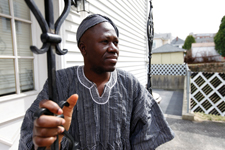 |
| MA candidate Ibrahim Sebiyam |
It certainly was a call to action for MA student Ibrahim Sebiyam. He grew up in Kpasenkpe, a village in northern Ghana, one of 69 children his chieftain father had by twenty wives. His father governed a waning tribal system of farming in which his subjects paid homage to him by working on his farm. After his father died in 1993, Sebiyam and his mother decided the son must go to college. His mother sold her personal belongings, while Sebiyam took on a series of menial jobs—brewing pito, a local alcoholic beverage; selling roadside drinks; shepherding; and washing bottles for a drug company.
After several years, they had raised enough money to send Sebiyam to teacher-training college in Tamale. That’s when he discovered the importance of empowering women. As a student Planned Parenthood volunteer, he spread an urgently needed message about family planning, reproductive health, and HIV to women in the community. “I wanted them to look beyond the small window of their experience, to think about their future, and not just to dwell on their present circumstances,” he says.
Since then, Sebiyam founded his own NGO, the Center for Youth and Women’s Empowerment, and in 2008 won a fellowship from the Ford Foundation’s International Fellowships Program (IFP) to study sustainable international development. He applied to the Heller School, he says, because he realized that Brandeis offered a course of study that would equip him better to achieve his dreams.
Those dreams? To influence decisions and social policies in Ghana; to raise money for his NGO; to continue educating girls and women to become self-supporting in rural villages, and to become a professor at one of Ghana’s universities. “When you graduate from Heller, you are no longer just a community person, you are a national person, and you won’t be in one place. I will go to the area where my help is needed most to develop rural services,” says Sebiyam.
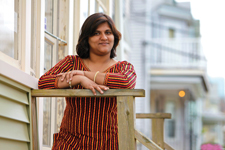 |
| MA candidate Sabita Parida |
The road to women’s empowerment—through literacy, family planning, health education, infant survival, or microloans—winds throughout the developing world. Growing up in Orissa, India’s poorest province, MA candidate Sabita Parida was still a young girl when she developed a strong sense of the injustice of women’s oppression.
“I was a little feminist; after all, every girl in India has to become a feminist, every girl has to fight for her rights—even for food,” says Parida, who is also a Ford IFP fellow. An early opportunity to assert herself occurred in fourth grade when Parida overheard her teacher dismiss girls’ mathematical abilities. Not long after, she earned the highest math grade in her state, putting to rest any doubts about her own prowess with numbers.
At age 12, she became a Girl Guide in the Indian equivalent to the Girl Scouts, and began teaching tribal girls basic literacy. “These kids were the poorest of the poor and had no access to education,” says Parida, who speaks five languages. Parida’s greatest inspiration, she says, is her mother, a woman who never had her own bank account or even knew how to write her signature, a requirement to vote in India.
“Teaching my mother to write her name was my first step in the world of development work,” says Parida. Next step: armed with her Heller degree, Parida plans to return to India and concentrate on issues that will strengthen the voice of women in Indian society, from enforcing dowry laws to winning recognition of the economic value of housework.
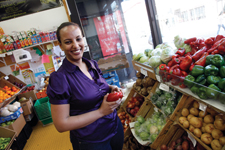 |
| MA candidate Hiwot T. Belay |
Hiwot T. Belay, the daughter of a retired air force colonel and U.N. administrator, grew up in Ethiopia’s capital, Addis Ababa, and came to Heller to earn a master’s in international health policy and management. “I have always been passionate about humanitarian assistance,” she says. After graduating from Addis Ababa University with a degree in sociology and social administration in 1998, Belay got her chance when she landed her first development job with World Vision, a Christian relief and development NGO. She worked as a communications and liaison officer, essentially promoting the NGO’s work to the community and donors and monitoring programs in the field. “I got a firsthand understanding of a rural community. I grew up in the city, but I came to understand how people in rural communities cope with recurrent drought, deforestation, and malnutrition,” she says.
Belay’s goal is to help reverse the high maternal mortality rate in her country caused by too few doctors, nonsterile conditions, poorly equipped health centers, and lack of knowledge about maternal health—not to mention mountains that prevent women from getting prenatal and delivery care.
“There’s a lot to do, and sometimes you feel tiny and the problems are that big,” says Belay, stretching her arms wide. Poverty and health, environmental decline, economic prosperity—these issues continue to be the core focus of Heller, says Dean Lynch. What’s changed over the last half a century is the school’s growing global response to social injustice. It’s reflected in the students, whether they come from Austinor Addis Ababa.
“If you asked every student who sets foot here, ‘Do you believe in universal human rights?’ he or she would answer, ‘absolutely,’” says Simon. “If you asked, ‘Do you believe that we have a responsibility to care for every single child on earth?’ that student would say, ‘absolutely.’ Our students are world citizens.”
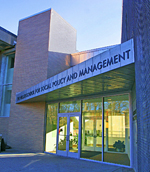 A Brief History of Heller
A Brief History of HellerBrandeis’ first professional school was established in 1959 amid rising concern about social problems here and around the world. At the time, the university’s first president, Abram Sacher, and several trustees perceived a need for a professional school of applied social science—not a conventional school of social work—to focus on issues like health care, poverty, aging, and disabilities.
Launched with a gift from Florence G. Heller, a leading social-welfare advocate, the Florence G. Heller Graduate School for Advanced Studies in Social Welfare, as it was then called, became a pioneering research and graduate school in the field of social-welfare policy. Its first group of seventeen mostly bow-tied professional social workers attended classes in a quaint cottage surrounded by a picket fence.
“When Heller was established fifty years ago, there wasn’t any school quite like it,” says Dean Lisa Lynch. “Heller pioneered the use of social-science theory and analysis to examine the root causes of social problems.” But that doesn’t mean Heller was ever satisfied to remain inside the walls of the ivory tower. Quite the opposite: faculty and students have always focused on applied research. “We’re not content to generate research just for the journals—we want to drive it directly into public policy, and that was true from the get-go,” says Lynch.
“The early faculty set in motion the idea that the Heller School was a place for government to come and find solutions to broad social problems,” says Stuart Altman, the Sol C. Chaikin Professor of National Health Policy, who twice served as dean. With President Lyndon Johnson’s Great Society reform efforts in the midsixties came a need to train professionals to lead child welfare organizations, oversee nonprofits, and manage government agencies at every level, Altman says. Heller attracted a bonanza of government-funded training grants and, in turn, produced scores of leaders who went on to serve in government, academia, and the nonprofit sector.
When Altman joined the Heller School in 1977 to begin his first stint as dean, Heller had to anticipate how best to leverage its influence in shaping progressive social policy in a shifting political and economic landscape. Over the ensuing decade, Altman beefed up the research arm of the school, building think tanks focusing on health policy; behavioral health; aging; children, youth, and families; and wealth and asset building.
Today, Heller brings in more than $11 million yearly in sponsored research funding through four social-policy research institutes, providing the enterprise with a strong engine. Many faculty members are engaged in implementing their social-policy research findings in the field. From an initial class of seventeen doctoral students, the school has grown to 500 students studying in five degree programs: a doctoral program; a master’s in public policy; an MBA in nonprofit management; and two master’s degree programs, an MA in sustainable international development and an MS in international health policy and management. The school’s physical footprint doubled with the 2006 addition of the Irving Schneider and Family building, and the cottage is long gone.





